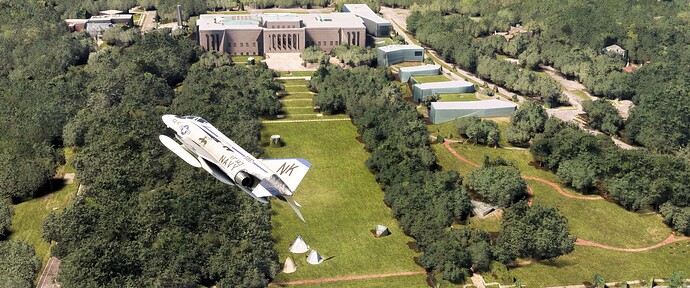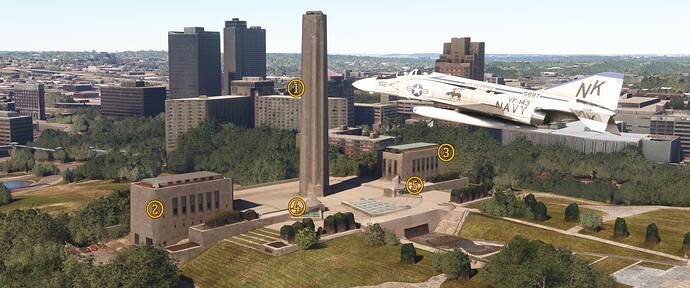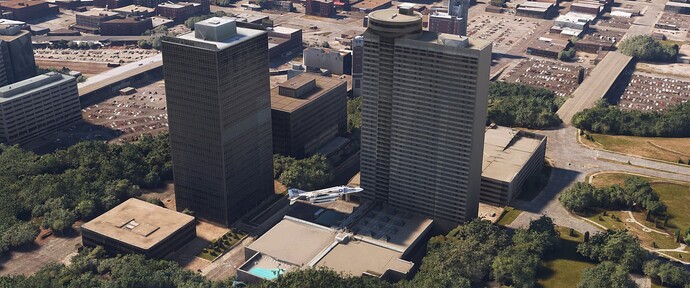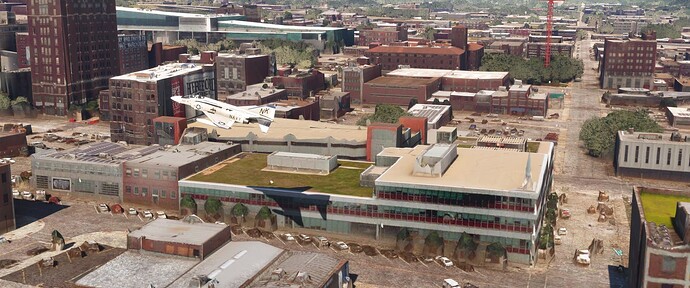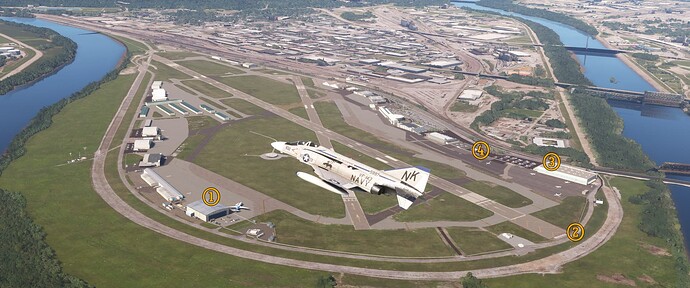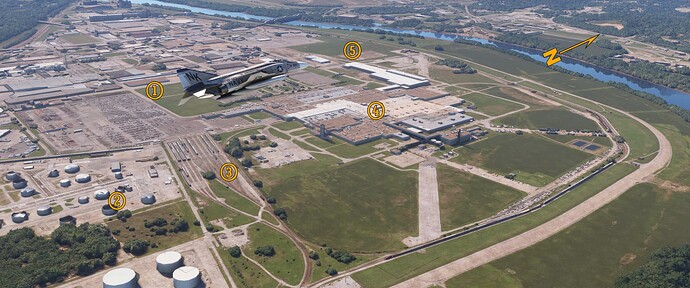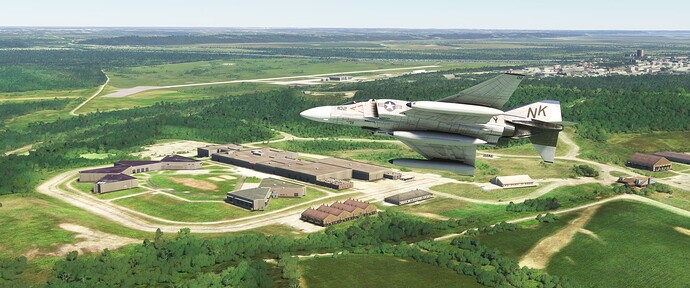Pee-Wee and Nag Over Middle America
St. Louis to Kansas City, Part Three
Pee-Wee says: We’re entering the home stretch, gang. Let’s jump right in!
![]() My, What Big Shuttlecocks You Have: The Nelson-Atkins Museum of Art
My, What Big Shuttlecocks You Have: The Nelson-Atkins Museum of Art
MSFS: 39.042598 -94.580870
Skyvector: 390233N0943451W
Pee-Wee says: It’s your turn to talk. Don’t cock it up.
Are you going to do this the entire time?
Does a cockatoo have feathers?
… ![]()
" Nag looked at her with mild disgust and cocked his head toward the door as if to say, ‘please leave.’ "
Anyway, upon his passing, William Nelson, publisher of the Kansas City Star newspaper, bequeathed his entire estate to the purchase of artwork for public display. Similarly, former schoolteacher and art aficionado Mary Atkins left more than $300,000 (nearly $10 million [€9 million] today) for the establishment of a public art museum in Kansas City. Trustees decided to combine Nelson’s and Atkins’s estates to create a single large museum. The Nelson-Atkins Museum of Art opened to the public on 11 December 1933.
Flush with cash, museum curators took advantage of the thriving worldwide art market as other museums, bankrupted by the Great Depression, struggled for survival. Nelson-Atkins’s collection swelled and before long it was one of the largest in the United States.
Pee-Wee says: We found the museum in the Rockhill neighborhood about four miles (six kilometers) south of downtown. Patterned after the Cleveland Museum of Art, the main building was originally two museums: the William Rockhill Nelson Gallery of Art in the west wing, and the Atkins Museum of Fine Arts in the east wing. To the right is the award-winning Bloch Building with its five glass pavilions rising above a vast underground gallery. The Hall Sculpture Park lies beneath the trees to the right of our Phantom, and Robert Morris’s triangular Glass Labyrinth maze/sclupture is visible just beyond.
In 1994 long-time Kansas Citians Morton and Estelle Sosland commissioned husband-and-wife artists Claes Oldenburg and Coosje can Bruggen to create a large sculpture for the museum. The artists contemplated different designs before settling on a fanciful quartet of oversized badminton birdies. Three of the 18-foot (5.4-meter) tall fiberglass and aluminum shuttlecocks lie on south lawn, with a fourth on the north. Thematically, the lawns represent the badminton court, with the museum building playing the part of the net.
Pee-Wee says: As with the Denver Airport’s installation of its iconic blue mustang known as “Blucipher,” the public’s response to the shuttlecocks was both swift and vocal, ranging from frothing support to unfettered disgust. Today, Kansas Citians and visitors alike have taken a liking to the quirky game pieces, and the shuttlecocks are now considered so much a part of the city’s culture they were featured during television coverage of Super Bowl LVIII.
Incidentally, the word “shuttlecock” is formed from the English words “shuttle” and “cock.” The badminton birdie’s back and forth motion is reminiscent of the wooden “shuttle” which carries the weft thread between layers of thread in a floor loom, and its feathers are like those of a rooster or “cock.” So, you can stop now.
Pee-Wee says: Sounds like a cock and bull story to me.
…![]()
![]() Should Have Been a POI: The National World War 1 Memorial and Museum
Should Have Been a POI: The National World War 1 Memorial and Museum
MSFS: 39.081 -94.586
Skyvector: 390452N0943510W
Barely one year after Armistice Day, the Liberty Memorial Association of Kansas City raised $2.5 million (almost $44 million [€3.9 million] today) for the construction of a memorial honoring the millions of Americans who fought and died in World War 1. Built atop a prominence south of downtown, the 47-acre (19-hectare) National World War 1 Memorial opened in 1926 and features the 217-foot (66-meter) tall Liberty Tower, Exhibition Hall, Memorial Hall, and a museum.
Pee-Wee says: Here we are flying north past the memorial. You can see (1) Liberty Tower, (2) the Exhibition Hall, inside which the museum displays temporary exhibits of equipment, artwork, and other historical artifacts, and (3) the Memorial Hall. Two sphinxes stand astride the tower, their wings folded across their faces: (4) “Memory” faces east toward the battlefields of Europe, its eyes shielded from the horrors of war, while (5) “Future” looks west, its eyes shielded from an unknown future.
An elevator and steps lead to an observation deck atop Liberty Tower, where visitors are treated to a panoramic view of Kansas City and its environs. At night, steam billows from the bulkhead atop the tower. Red and orange lights illuminate the steam, giving the appearance of a funeral pyre (unfortunately, not in MSFS).
The Memorial played a pivotal role in the landmark 1983 television drama The Day After when Dr. Oakes and his doomed daughter visit here before the nuclear attack on Kansas City, and again when the dying Oakes returns near the film’s end.
Pee-Wee says: The Day After is one of the more depressing films I’ve watched, but pales in comparison to the emotional onslaught that is Barry Hines’s 1984 apocalyptic drama Threads. The very last scene, during which young Jane delivers her baby? Wow. ![]()
![]() An Egregious Engineering Error: The Hyatt Regency Kansas City
An Egregious Engineering Error: The Hyatt Regency Kansas City
MSFS: 39.084969 -94.579787
Skyvector: 390506N0943447W
Pee-Wee says: On 17 June 1981, the newly constructed Hyatt Regency Kansas City hotel gained international notoriety when two of its suspended lobby walkways collapsed, killing 114 people and injuring another 216. Investigators blamed chief engineer Jack Gillum and Havens Steel, manufacturer of the steelwork that supported the walkways, citing poor communications and oversight, and an egregious and elementary design flaw.
The walkways were each suspended from the lobby ceiling by six steel rods connected to box beams carrying the walkways’ decks. As originally designed the second-floor walkway’s suspension rods passed through those of the fourth-floor walkway. But the beams were redesigned so that the second-floor rods connected directly to the fourth-floor walkway’s support beams, which meant that the upper walkway was carrying its own weight…and that of the lower walkway!
Pee-Wee says: Investigators also faulted the city’s emergency response. Fire fighters and first responders lacked proper equipment to extricate victims from the wreckage and were forced to borrow saws, jacks, and other equipment from local residents and construction companies.
Lessons from the Hyatt Regency disaster rippled through the construction industry, bringing much-needed improvements in engineering education, structural design, and project management in an era when many large construction projects were being fast-tracked to completion, sometimes with disastrous results.
The hotel was rebranded as the “Sheraton Kansas City Hotel at Crown Center” in 2011.
Here we are turning north past the former Hyatt Regency (the high-rise building on the right). The lobby is directly below and to the right of our Phantom (in shadow, with the twelve pyramid-shaped skylights on its roof). The collapsed walkways ran beneath the row of skylights on the right. Today, the lobby remains structurally unchanged from 1981, with the notable lack of suspended walkways.
Pee-Wee says: Whew! I think that’s enough nuclear holocaust and death for today. Let’s talk about something less awful, like airlines and spaceships! ![]()
![]() Part 121 to the Moon: Trans World Airlines’ Headquarters and Moonliner II
Part 121 to the Moon: Trans World Airlines’ Headquarters and Moonliner II
MSFS: 39.092278 -94.584381
Skyvector: 390532N0943504W
Trans World Airlines’ relationship with Kansas City began in 1932 when progenitor Transcontinental Air Transport established its primary base of operations at the Kansas City Municipal Airport northwest of downtown. TWA relocated its corporate headquarters from the airport to a new building south of downtown Kansas City in 1956. After the airline moved its headquarters to New York City in 1964, the iconic red-and-white building at the corner of 18th Street and Baltimore Avenue continued as an accounting center, ticket sales center, and even a flight attendant school. Restored to its former glory in 2006, the building now houses advertising agency Barkley Inc.
Pee-Wee says: TWA teamed with Disney to produce the 76-foot (23-meter) tall Moonliner for Disneyland’s Tomorrowland in Anaheim, California. Designed by Disney with help from Wernher von Braun himself, the iconic spaceship was painted in TWA’s colors and stood taller than Cinderella’s Castle. At around the same time, TWA placed a 22-foot (6.7-meter) replica of the spaceship, dubbed Moonliner II, atop its Corporate Headquarters in Kansas City. Moonliner II now resides at the Airline History Museum at Wheeler Downtown Airport, but a new replica, dubbed Moonliner IV, was placed atop the restored headquarters building in 2006, and it’s that replica we wanted to see in MSFS. ![]()
Pee-Wee says: And we failed. More correctly, Asobo failed! Photogrammetry certainly has its limitations, and while you can clearly see Moonliner IV atop the old TWA Headquarters, the representation is…somewhat lacking! (“Dear Barkley: Sorry about the windows.”
Want to see Moonliner I on location at Disney? Head over to www.historicaerials.com and search for coordinates 33.81207 -117.91685, then select the 1963 aerial image and look for the rocket-shaped shadow. Gosh, I love the Internet!
![]() Who Put That Hill Next to My Airport?: Charles B. Wheeler Downtown Airport (KMKC)
Who Put That Hill Next to My Airport?: Charles B. Wheeler Downtown Airport (KMKC)
MSFS: 39.124194 -94.592655
Skyvector: 390727N0943534W
Scenery by JustOkayPilot @ www.flightsim.to
In 1927 Kansas City replaced its original airport at Raytown, Missouri with the Kansas City Municipal Airport. The field had two 2,800-foot (853-meter) runways, a third shorter strip, hangars, and a passenger terminal and maintenance hangar for Transcontinental Air Transport (later Transcontinental & Western Airlines). By the 1960’s, Municipal’s primary runway was stressed and lengthened to accommodate large jet transports and provided all-weather capability with a single Instrument Landing System (ILS) for aircraft landing from the north.
Pee-Wee says: There was one drawback to the arrangement. The southern approach was obstructed by terrain and buildings across the river in downtown, which meant that, if instrument meteorological conditions (IMC) prevailed, airplanes were essentially restricted to landing on Runway 18, regardless of the wind.
On 1 July 1965, Continental Airlines Flight 12 from Los Angeles overran 7,000-foot (2,130-meter) long Runway 18. The approach and landing were normal but the Boeing 707 hydroplaned and was unable to stop on the runway. Investigators determined that the crew was not informed of the 5-knot (9-kilometer per hour) tailwind or the heavy rain at the field. Three passengers and two crew received minor injuries, but the aircraft, 707-124 N70773, was destroyed. Had an instrument approach been available into the wind the airplane may have stopped on the pavement.
Pee-Wee says: There were numerous incidents and accidents involving jet airliners hydroplaning during landing in the early 1960s, and the industry’s safety apparatus soon set itself to the problem. The results were changes that seem obvious now but were groundbreaking then: grooved runways and the dispatch requirement to add 15% to an aircraft’s landing distance on wet runways.
Pee-Wee says: Here we are flying north past Wheeler Downtown Airport. I’ve marked (1) the Airline History Museum with its Lockheed L-1011 (or at least a reasonable facsimile) parked alongside, (2) the approximate location on Lou Holland Drive where Continental Flight 12 finally stopped, (3) the original Trans Continental & Western maintenance hangar, now Signature Flight Support and the TWA Museum, and (4) the approximate location of the original passenger terminal.
![]() From General Mitchell to General Motors: Fairfax Airport
From General Mitchell to General Motors: Fairfax Airport
MSFS: 39.147 -94.603
Skyvector: 390852N0943613W
Across the river from Wheeler is the closed Fairfax Airport, from where TAT’s rival Universal Air Transport (later American Airlines) operated a portion of its air-rail transcontinental service. Before World War 2, Fairfax was the home of several notable aeronautical endeavors, including Southwest Air Fast Express, Rearwin, American Eagle Aircraft, and Curtiss Flying Service.
Pee-Wee says: In 1941 the U.S. Government built an assembly plant on Fairfax’s northwest corner for the assembly of North American B-25 medium bombers. The plant was huge: in one month in 1945 its 24,000 employees produced a record 315 B-25s. During the war, all civilian operations at Fairfax moved to Municipal Airport but returned briefly after V-J Day. General Motors purchased the factory outright and closed the airport in 1965 to make way for a more modern factory, ending more than sixty years of aviation at Fairfax.
The 1951 Missouri River flood inundated Fairfax Airport and severely damaged its infrastructure, including TWA’s aircraft overhaul center in the former B-25 modification center. Intent on keeping TWA in Kansas City, the town built a new airport on farmland northwest of town, far from the river’s floodplain, and TWA’s new Kansas City Overhaul Center opened there in 1957. The new Mid-Continent Airport grew and is today the Kansas City International Airport (KMCI).
Pee-Wee says: While most of Fairfax was plowed under in favor of automobile manufacture, some of the field’s infrastructure remains. Here you can see (1) the site of the original passenger terminal, (2) the Kansas City Terminal’s storage tanks, (3) the site of the B-25 modification center/TWA overhaul center, now a railyard for outgoing auto racks, (4) the new G-M factory, and (5) the field where North American’s B-25 factory stood. Further east you can also see the remnants of three of the field’s runways and several taxiways. Sadly, it seems that no historic structures remain.
![]() Worse Than a Big Chicken Dinner: United States Disciplinary Barracks, Fort Leavenworth
Worse Than a Big Chicken Dinner: United States Disciplinary Barracks, Fort Leavenworth
MSFS: 39.377 -94.935
Skyvector: 392240N0945607W
Standing beside the Missouri River twenty-five miles (40 kilometers) northwest of Kansas City is Fort Leavenworth, location of the most notorious military prison in America. Since 1874 Leavenworth has confined U.S. soldiers, sailors, and airmen convicted by courts martial of violating the Uniform Code of Military Justice (UCMJ). The original prison, nicknamed “The Castle” because of its imposing stone walls and hilltop position overlooking the river, was replaced by the current United States Disciplinary Barracks (USDB) in September 2002. Over 400 inmates are currently interred here.
Pee-Wee says: Not all UCMJ violators land in Leavenworth. To wind up here you have to do something really bad, like sell military secrets, massacre civilians, murder a bunch of your fellow soldiers, or order your Marines to kill Private Santiago.
Here we are turning northeast around the USDB. The original “Castle” stood in the distance just above our Phantom’s wingtip. Sherman Army Air Field is visible above our canopy, and Kansas City International Airport can be seen in the extreme distance.
By the way, don’t confuse this facility with the nearby United States Penitentiary, Leavenworth. One of the first Federal prisons in America, USP Leavenworth houses only civilian criminals.
We learned several important things during this marathon tour. First, even seemingly uninteresting places have stories to uncover. Second, MSFS’s photogrammetric cities are great but need improvement.
Pee-Wee says: Third, the F-4 is totally unsuitable for scouting closely spaced sites within a metropolitan area. It was like trying to garage a Ferrari in overdrive. ![]()
Thanks for hanging with us, everyone! We’re going to take another break this weekend and do some hiking next week, so expect another Skytour sometime later this month.
Pee-Wee says: Hey, we didn’t mention that Harry Truman, 33rd President of the United States, was from Missouri and lived very near the Independence Temple. While he was in office, a woman from Missouri sent him a puppy named “Feller.” Do you know what type of dog he was?
A cocker spaniel.
Bye for now! ![]()
